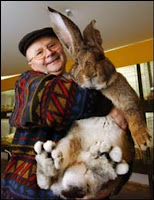
In the end of the book, when Lennie is at the river after he has run away because he killed Curely’s wife, he has a vision of seeing his Aunt Clara, and a gigantic rabbit. Aunt Clara talked about how George would always do nice things for Lennie such as giving him more than half the pie, but Lennie never gave a thought about George. She also says how if it wasn’t for him, George could have a great life, and how Lennie wouldn’t be able to leave, instead he would stick around and “stew the b’Jesus outa George all the time”. Then the giant rabbit appeared, and talked about how Lennie would never be able to tend rabbits, he would forget about them and they would starve. The rabbit also told Lennie that George is sick of him, and he’s going to beat the hell out of him, and then leave him all alone.
I think Lennie had that vision because he knew he had done something really bad, but his childlike mind couldn’t understand the amount of trouble that he had gotten into. I also think that it is foreshadowing his death. These two things, his aunt and a rabbit, which meant so much to him, were taunting him, sort of giving him a recap of his life, and how he was no good.
I think they weren’t including the movie because they were a little bit random, and it would ruin the mood, of how George was running to find Lennie, and then he found him, calmed him down, and shot him. If Lennie suddenly starting having visions of things, it would not make the ending as suspenseful. Also, the story doesn’t quite have an insight of anyone’s mind, so if suddenly we are seeing what Lennie is thinking, that wouldn’t quite fit.
I think the story wasn’t the greatest or most interesting, but it wasn’t terrible either. It had very good descriptions of scenery, and people. And Steinbeck was good at setting the mood of the story. At the end, I was quite shocked with what had happened. I mean, I know that it wouldn’t be ‘everyone lives happily ever after’, with all the death and all, but I didn’t want a character that was so sweet and confused to die. In the end of the book, the only one who truly understands what George was going though was Slim, so he asked him to get a drink. I think if George truly still wanted to, he could possibly share the land with Slim, because he seems to be a smart person, who would be easy to get along with. In the movie, it shows George on a train, going away. I think he was possibly just trying to get away from where Lennie was, not wanting to think about the fact that he shot him, and that he wasn’t there anymore. And I did like after how it showed a flashback of George and Lennie together, having a good time. It made the mood a little bit lighter, knowing that Lennie wouldn’t be causing any more trouble.













